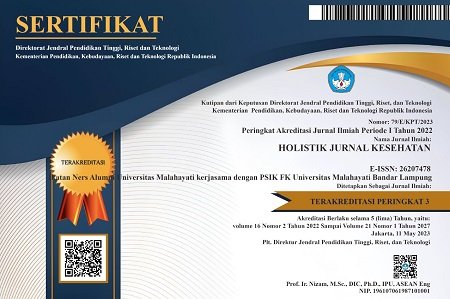Implementation of a video-messaging service in the neonatal intensive care unit: A literature review
Abstract
Background: The NICU room is a critical area for newborns where various problems, such as anxiety and bonding parents with their babies, limited workforce, communication and education difficulties. Video service technology can be a solution to these problems.
Purpose: Know the effectiveness of using video services in NICU nursing.
Method: The form of a literatur review. database searches are carried out through ProQuest, Scopus, Science Direct, Ebsco and PubMed since 2018-2023.
Result: From the results of a review of 10 journals, video service provides positive benefits for patients' parents, NICU professionals, and nurses. Video service can be a bridge of communication between parents and babies, parents and health workers, and increase nurses' job satisfaction.
Conclusion: Further studies are needed to examine more deeply the benefits of video service for nurses in the NICU room.
Keywords: Live Video Service; Neonatal Care; Parent
Pendahuluan: Ruang NICU merupakan area kritis bayi baru lahir dimana berbagai permasalahan, seperti kecemasan dan bonding orangtua dengan bayinya, kesibukan tenaga kerja yang terbatas, kesulitan komunikasi dan edukasi. Teknologi video service dapat menjadi solusi untuk permasalahan tersebut.
Tujuan: Mengetahui efektivitas penggunaan video service dalam keperawatan NICU.
Metode: Metode yang digunakan dalam penelitian ini adalah literature review. Penelusuran artikel akademik melalui Online Database pencarian melalui Online Database diantaranya ProQuest, Scopus, Science Direct, Ebsco dan PubMed dari tahun 2018-2023.
Hasil: Dari hasil telaah 10 jurnal, video service memberikan manfaat positif bagi orang tua pasien, profesional di ruang NICU, dan perawat. Video service dapat menjadi jembatan komunikasi antara orangtua dan bayi, orang tua dan petugas kesehatan, serta meningkatkan kepuasan kerja perawat.
Simpulan: Studi lanjutan diperlukan untuk mengkaji lebih dalam manfaat video service untuk perawat di ruang NICU.
References
Anggraeni, L. D., Indiyah, E. S., & Daryati, S. (2019). Pengaruh posisi pronasi pada bayi prematur terhadap perubahan hemodinamik. Journal of Holistic Nursing Science, 6(2), 52-57.
Bott, S., Dantas Fernandez, N., Narciso, J., MacAlpine, J., Quain, N., Rettie, J., & Shah, V. (2023). Building Connections with Families: Implementation of a Video-Messaging Service in the Neonatal Intensive Care Unit. Children, 10(8), 1338.
Cabon, S. (2019). Monitoring of premature newborns by video and audio analyses (Doctoral dissertation, Université de Rennes).
Caporali, C., Pisoni, C., Gasparini, L., Ballante, E., Zecca, M., Orcesi, S., & Provenzi, L. (2020). A global perspective on parental stress in the neonatal intensive care unit: a meta-analytic study. Journal of Perinatology, 40(12), 1739-1752.
Fang, J. L., Collura, C. A., Johnson, R. V., Asay, G. F., Carey, W. A., Derleth, D. P., & Colby, C. E. (2016). Emergency video telemedicine consultation for newborn resuscitations: the Mayo Clinic experience. In Mayo Clinic Proceedings (Vol. 91, No. 12, pp. 1735-1743). Elsevier.
Gallagher, K., Hayns-Worthington, R., Marlow, N., Meek, J., & Chant, K. (2023). Parental experiences of live video streaming technology in neonatal care in England: a qualitative study. BMC pediatrics, 23(1), 1-8.
Gray, J. E., Safran, C., Davis, R. B., Pompilio-Weitzner, G., Stewart, J. E., Zaccagnini, L., & Pursley, D. (2000). Baby CareLink: using the internet and telemedicine to improve care for high-risk infants. Pediatrics, 106(6), 1318-1324.
Hoffmann, J., Reimer, A., Mause, L., Müller, A., Neo-CamCare, Dresbach, T., & Scholten, N. (2022). Driving new technologies in hospitals: association of organizational and personal factors with the readiness of neonatal intensive care unit staf toward webcam implementation. Diakses dari : https://pubmed.ncbi.nlm.nih.gov/35715804/
Kilcullen, M. L., Kandasamy, Y., Evans, M., Kanagasignam, Y., Atkinson, I., van der Valk, S., & Baxter, M. (2020). Neonatal nurses’ perceptions of using live streaming video cameras to view infants in a regional NICU. Journal of Neonatal Nursing, 26(4), 207-211.
Kirolos, S., Sutcliffe, L., Clausen, M. G., Abernethy, C., Shanmugalingam, S., Bauwens, N., & Patel, N. (2021). Asynchronous video messaging promotes family involvement and mitigates separation in neonatal care. Archives of Disease in Childhood-Fetal and Neonatal Edition, 106(2), 172-177.
Kubicka, Z., Zahr, E., Clark, P., Williams, D., Berbert, L., & Arzuaga, B. (2021). Use of an internet camera system in the neonatal intensive care unit: parental and nursing perspectives and its effects on stress. Journal of Perinatology, 41(8), 2048-2056.
Le Bris, A., Mazille-Orfanos, N., Simonot, P., Luherne, M., Flamant, C., Gascoin, G., & Pladys, P. (2020). Parents’ and healthcare professionals’ perceptions of the use of live video recording in neonatal units: a focus group study. BMC pediatrics, 20(1), 1-9.
Mause, L., Hoffmann, J., Reimer, A., Dresbach, T., Horenkamp‐Sonntag, D., Klein, M., & Wobbe‐Ribinski, S. (2022). Trust in medical professionals and its influence on the stress experience of parents of premature infants. Acta Paediatrica, 111(3), 527-535.
Rahayuningsih, S. I. (2012). Tingkat Stres Orang Tua Dan Interakaksi bersama bayinya diruang NICU RDUD ZA Banda Aceh. Idea Nursing Jurnal, 3(1), 50-61.
Reimer, A., Mause, L., Hoffmann, J., Mantell, P., Stümpel, J., Dresbach, T., & Scholten, N. (2021). Webcam use in German neonatological intensive care units: an interview study on parental expectations and experiences. Diakses dari: https://pubmed.ncbi.nlm.nih.gov/34521406/
Sampurna, M. T. A., Visuddho, V., Permana, P. B. D., Putri, R., Hariyani, M. T. U., Etika, R., & Shidqi, A. (2022). Pemberdayaan Orang Tua Bayi Keluaran Unit Rawat Intensif Neonatus (Nicu) Melalui Pembentukan Komunitas Terkait Bayi Prematur.
Stümpel J, Dörrhöfer A, Mantell P, Jannes C, Reimer A and Woopen C (2023) Webcam-use in the NICU-setting from the perspective of Health Care Professionals and its implication for communication with parents. Diakses dari: https://www.frontiersin.org/articles/10.3389/fcomm.2023.1205950/full
Suir, I., Oosterhaven, J., Boonzaaijer, M., Nuysink, J., & Jongmans, M. (2022). The AIMS home-video method: parental experiences and appraisal for use in neonatal follow-up clinics. BMC pediatrics, 22(1), 338.
Tat, F. (2018). Hubungan Tingkat Pengetahuan dan Perilaku Merawat Bayi Dengan Status Kesehatan Bayi Post Perawatan Nicu Di Rsud Wz Johannes Kupang. Chmk Nursing Scientific Journal, 2(1), 18-18.
Weber, J. C., Sohn, K., Sauers-Ford, H. S., Hanhauser, A., Tancredi, D. J., Marcin, J. P., & Hoffman, K. R. (2021). Impact of a parent video viewing program in the neonatal intensive care unit. Telemedicine and e-Health, 27(6), 679-685.
Yuniwati, T. (2022). Alasan Bayi Harus Dirawat di NICU. Diakses dari: https://www.klikdokter.com/ibu-anak/kesehatan-bayi/alasan-bayi-dirawat-di-nicu
DOI: https://doi.org/10.33024/hjk.v17i8.12887
Refbacks
- There are currently no refbacks.
Copyright (c) 2023 Holistik Jurnal Kesehatan

This work is licensed under a Creative Commons Attribution-NonCommercial 4.0 International License.














